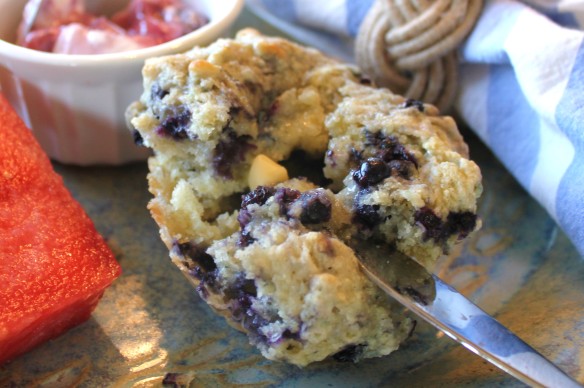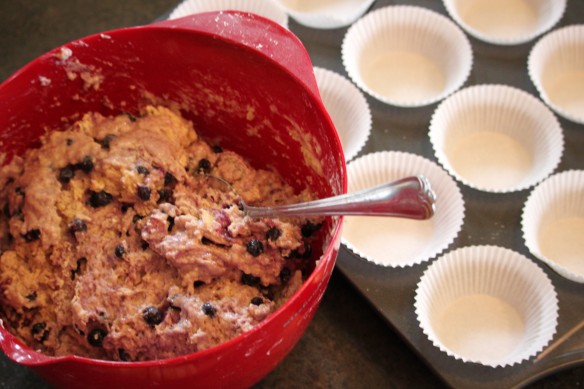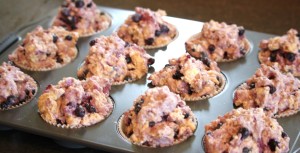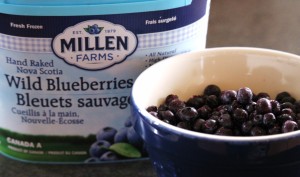Sharon Jessup Joyce

My sister Susan is a Cordon Bleu-trained chef. But even before her formal food education, she was creative and gifted in the kitchen, with a passion for sustainable and local eating when it was considered a bit odd, instead of hip or responsible. She has always loved the challenge of using what you have on hand. Susan’s starting point for a meal is usually “What ingredients do I have?” or “What’s in season?” as opposed to “What ingredients do I need to get?” She has run professional kitchens and raised five children on this philisophy, turning out amazing meals, day after day, year after year.
I thought of this recently when I ran out of flour, sugar and buttermilk at the Nova Scotia house. I wanted to make blueberry muffins, using a memorized recipe from the good old Five Roses Cookbook, a standby in my grandmother’s kitchen, and a favourite of mine for classic baked goods, such as pound cake, biscuits, scones and cake-style muffins. But I didn’t want to drive into town to the grocery store, so I improvised, Susan-style, using maple sugar instead of regular sugar, 1 part corn meal to 3 parts flour, and 1 part yogurt whey (I was making yogurt cheese at the time) to 2 parts buttermilk.
It occurred to me, when I made these substitutions, that Susan’s philosophy has influenced me much more than I realized: I’m not even using the Five Roses muffin recipe as published. I’ve already tweaked this recipe by reducing the sugar or using maple sugar, increasing the amount of fruit (my late mother-in-law used to say my muffins were mostly fruit, with just enough batter to hold a muffin shape), and using buttermilk instead of regular milk.
After decades of trial and error in the kitchen, I know the more we understand how ingredients and flavours work, the more we are freed from a recipe straightjacket. I’ve found my kitchen art by developing my understanding of cooking chemistry (the function each ingredient serves) and cooking math (the proportions of each ingredient needed). Getting out of the recipe straightjacket allows us to change any dish to our tastes or needs. For example, I can now create low-fat, non-wheat, dairy-free and vegetarian versions of all sorts of dishes that I wanted to keep in my repertoire. Of course, this brave experimental approach sometimes results in garbage. I once created an homage to the song “Scarborough Fair,” by seasoning sole with parsley, sage, rosemary and thyme. It tasted horrible. That day I learned delicate white fish does not want to be paired with robust, woodsy herbs like rosemary and sage. But since that combination of herbs is lovely with poultry, maybe it would work in a vegetarian stew with root veggies and great northern beans? It did. It was delicious.
So here, as a tribute to Susan, who has always encouraged me to have fun, be brave and “just try it and see,” is my favourite fruit muffin recipe, which – in true Susan style – is not a recipe, but a set of guidelines and proportions I’ve worked out over the years. The nice thing about experimenting with muffins is that they are the most forgiving of pastries.
And those blueberry-corn meal muffins tasted sensational, by the way.

Fruit muffins (with the Five Roses Cookbook recipe as a starting place)
Ingredients
- 3 cups flour
- 1/4 to 1/3 cup sugar
- 4 teaspoons baking powder
- 1/2 teaspoon salt
- 1/2 to 1 teaspoon spices (e.g., cinnamon, nutmeg, ginger, allspice)
- 3 eggs
- 1/4 cup melted butter or vegetable oil
- 1 1/2 cups buttermilk or other milk (e.g., almond milk)
- 1 teaspoon vanilla (optional)
- 1 1/2 to 2 cups fruit
Directions
- Blend all dry ingredients in a medium-sized bowl.

- Melt butter and mix with buttermilk.
- Stir in vanilla (if using).
- Beat eggs and add to milk-butter mixture.
- Pour liquid mixture all at once over dry mixture and stir gently until just blended.
- Scoop muffin batter into muffin tins. Many recipes suggest filling muffin tins 2/3 full; I suggest you fill them above the top (see photo above), so the muffins will be prettier and more tender.
- Preheat oven to 425 degrees F or 400 degrees F convect bake.
- Bake muffins in fully preheated oven for 14 to 20 minutes. Muffins are done when tops are golden. You will probably need the full 20 minutes if you used lots of fruit.
Tips for variations
Flour: I usually use Five Roses Never Bleached all-purpose flour or a mixture of wheat flour with spelt, kamut or oat flour. If I use whole-grain flour, I reduce it by 1 ounce for each cup of flour and increase the baking powder by 1/2 teaspoon. I find that up to 40% whole grain flour or cornmeal doesn’t really affect texture much. Spelt and kamut are silkier than wheat, so the resulting dough or batter is softer and stickier. Resist the temptation to add more flour! The muffins will be fine, though easier to manage if cooked in paper muffin tin liners.
Sugar: I substitute brown sugar or maple sugar for white sugar. We use a lot of maple sugar at our house, which we often buy at Acadian Maple Products. Maple sugar is good with everything, but especially nice with apple and rhubarb, and brown sugar is lovely with peaches. If you use honey or maple syrup, the texture of your muffins will change (they will rise less, for one thing), but they will still be tasty. Cut back your milk by 1/4 cup. I do take into account the relative sweetness of the fruit, adding a little less sugar for peach muffins, for example, and more for rhubarb.
Butter or oil and nuts/seeds: I usually use melted butter, but vegetable oil, or nut or seed oil work well, too. I don’t often put nuts or seeds in my muffins because Adrian doesn’t care much for them, and there are some nut and seed allergies to consider, but I have put slivered almonds in peach muffins and topped cherrry muffins with roasted hazelnut dust – both tasty additions.
Toppings: You can put a topping on muffins. Brush the cooked muffins, when they are still warm, with a bit of melted butter, and then roll them, top-down, on cinnamon sugar, or powdered or chopped nuts. I have given apple-spice muffins with a cinnamon-sugar topping as a gift, and they are always a hit.
Using fruit in muffins
Fruit: Most fruits work better in this recipe if they have been cooked down or roasted first (see below). As I said, I love to really pack the fruit into my muffins, which means the muffins take a little longer to cook. If you open one up fresh from the oven, and it is not quite cooked in the centre, put the muffins back in the warm oven (still in the muffin tin), with the oven off, for another 5 minutes.
Cooking down fruit: This works well for apples, peaches, nectarines and apricots. Peel and dice the fruit and cook it, uncovered, in a small saucepan, along with a bit of water, a bit of maple syrup, boiled apple cider and apple-loving spices, such as cinnamon, cloves, allspice and nutmeg, or peach-loving spices such as ginger or cinnamon. Cook the fruit until it is soft and the liquid has reduced down to the consistency of thin syrup. If you want to cook fruit until it is just tender, strain and measure the liquid in the saucepan, and replace that amount of buttermilk in your recipe with the fruit cooking liquid. I generally use 3 or 4 apples or peaches per batch of muffins, depending on the size of the fruit. When it comes to the best variety of apple for muffins, I like Macintosh, Granny Smith, Northern Spy and Cortland, but I’d say anything except Delicious or Golden Delicious works. A combination of different apple varieties is great in late summer/early fall, when there are so many fresh apples to choose from.
Roasting fruit: Clean and cut fruit (e.g., strawberries, peaches, rhubarb, cherries) into bite-sized pieces. I usually roast mine in a pyrex cake pan, which is easily cleaned. Allow 2 cups of fruit for every 1 cup of finished roasted fruit. Add a bit of sugar to taste (I use very little, but Adrian prefers more) and roast in a 350-degree F oven until fruit is falling apart and juices have been fully released. Stir in cornstarch (about 1 tablespoon for every two cups of raw fruit) and return to oven for 15 to 20 minutes. Your finished product should be about the consistency of canned cherry pie filling – but it will taste much, much better!
Raw fruit: Rasberries, blackberries and wild blueberries can be used fresh or frozen. Just toss the fruit with about a teaspoon of flour for every cup of fruit before adding to the batter. A mixture of rasberries and blueberries makes very pretty and tasty muffins.
When these various fruits are in season, I prepare batches of them according to how we use them (e.g., cooked peaches, roasted strawberries or fresh blueberries) and put  them in freezer bags in 1-cup or 2-cup batches. They don’t take up much room and are delicious in so many things. Here in Nova Scotia, I don’t have access to my freezer of fruit, so I bought a container of local frozen blueberries from Millen Farms. I got a 1 kg tub for less than I would have to pay in Ontario for fresh wild blueberries in season, and they are perfect – firm, ripe berries with no twigs or leaves to sort and discard, and really nice flavour. These are a great find, and I’m supporting a local food producer – I know Susan will approve!
them in freezer bags in 1-cup or 2-cup batches. They don’t take up much room and are delicious in so many things. Here in Nova Scotia, I don’t have access to my freezer of fruit, so I bought a container of local frozen blueberries from Millen Farms. I got a 1 kg tub for less than I would have to pay in Ontario for fresh wild blueberries in season, and they are perfect – firm, ripe berries with no twigs or leaves to sort and discard, and really nice flavour. These are a great find, and I’m supporting a local food producer – I know Susan will approve!
| Sharon lives in Kingston, Ontario, and Hacketts Cove, NS, and is grateful for everything she learned from her big sister. |
| Welcome to our family’s discussion forum on food. If you’d like to submit a post, please consider yourself family, and email us at familyfoodforum@gmail.com. |
“After a good dinner, one can forgive anybody, even one’s own relations.”
– Oscar Wilde, A Woman of No Importance
|
|










